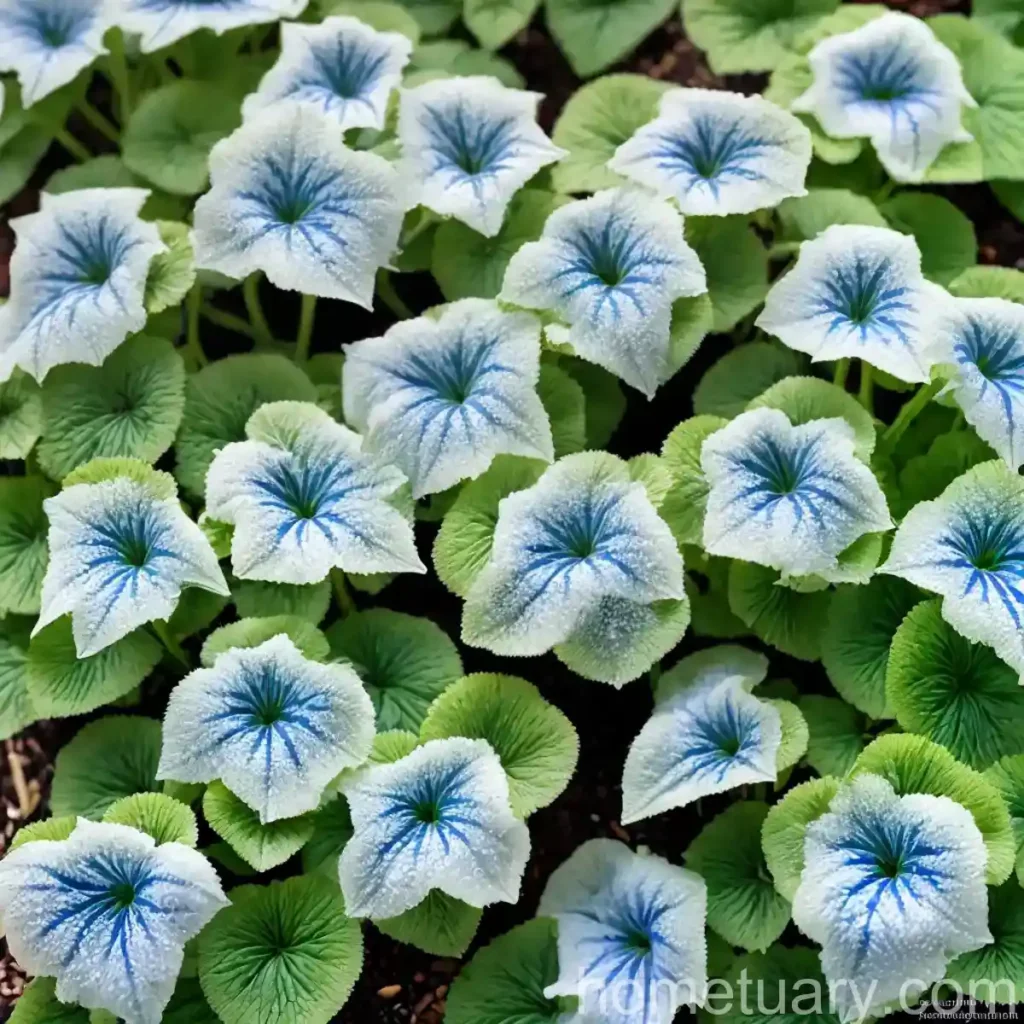Siberian Bugloss (Brunnera macrophylla ‘Hadspen Cream’)
Siberian bugloss, scientifically known as Brunnera macrophylla ‘Hadspen Cream’, is a charming perennial plant that belongs to the Boraginaceae family. This species hails from Siberia, and its stunning blue flowers and heart-shaped foliage make it a popular choice for gardeners seeking shade-loving ornamental plants. In this comprehensive guide, we will delve into the various aspects of Siberian bugloss, including its cultural requirements, propagation, common uses, and tips for maintaining its health and vibrancy.
What is Siberian Bugloss?
Siberian bugloss, also commonly referred to as large-leaf Siberian forget-me-not, is a herbaceous perennial plant that is widely prized for its captivating foliage and delicate blue flowers. This species typically reaches a height of 12 to 18 inches and spreads out to form a lush ground cover in shaded areas. The ‘Hadspen Cream’ variety is particularly esteemed for its striking variegated leaves, which feature a creamy white margin that contrasts beautifully with the green center.
Key Takeaways – Siberian Bugloss (Brunnera macrophylla ‘Hadspen Cream’)
Before we dive into the specific details of Siberian bugloss, here are the key takeaways that we will explore in this guide:
- Cultural requirements, including water, sunlight, fertilizer, and soil preferences
- Pruning techniques and propagation methods for Siberian bugloss
- Common uses of this plant in landscaping and gardening
- Identification of common diseases and pests that affect Siberian bugloss
- Insights and tips from botanists for successfully growing and caring for this species
- Fun facts about Siberian bugloss
- Links to external resources for further information
Now let’s delve into each of these aspects in detail to better understand how to cultivate and appreciate the beauty of Siberian bugloss in various gardening settings.
Culture
The successful cultivation of Siberian bugloss hinges on understanding and fulfilling its specific cultural requirements. From water and sunlight to soil and fertilizer, here’s what you need to know to foster the optimal environment for this stunning plant.
Water
Siberian bugloss thrives in well-drained, moist soil, making it important to ensure consistent watering, particularly during dry spells. While it does not tolerate waterlogged conditions, it appreciates a regular water supply, especially in the absence of natural rainfall. Aim to keep the soil consistently moist but not saturated to support healthy growth and flowering.
Sunlight
As a shade-loving plant, Siberian bugloss excels in environments with partial to full shade. When planted in excessively sunny areas, its delicate foliage is prone to scorching, leading to diminished vigor and attractiveness. Optimal locations include woodland gardens, under the canopy of taller trees, or along the northern or eastern sides of buildings where it can bask in dappled sunlight.
Fertilizer
A balanced, slow-release fertilizer applied in spring can bolster the growth and vibrancy of Siberian bugloss. Look for a fertilizer with equal parts nitrogen, phosphorus, and potassium to provide the necessary nutrients without promoting excessive leaf growth at the expense of blossoms. When applying fertilizer, follow the manufacturer’s guidelines to prevent overfeeding, which can lead to an imbalance in nutrients and potentially harm the plant.
Soil
The ideal soil for Siberian bugloss is rich, humus-laden, and well-drained. It is imperative to avoid heavy, waterlogged soils that can pose a risk to the plant’s health. Consider amending the soil with organic matter, such as compost or well-rotted manure, to augment its fertility and drainage capabilities. Additionally, maintaining slightly acidic to neutral soil conditions (pH 6.0 to 7.5) can contribute to the plant’s overall well-being.
Pruning
Pruning is an essential aspect of maintaining the health and aesthetics of Siberian bugloss. By implementing proper pruning techniques, you can encourage robust growth while preventing the plant from becoming overly unruly or invasive.
- Remove any damaged, diseased, or dead foliage throughout the growing season to promote the plant’s vitality and curb the spread of diseases.
- After the flowering period, trim back the spent flower stems to enhance the plant’s appearance and redirect its energy towards new growth and potential reblooming.
- In early spring, consider cutting back the entire plant to ground level to rejuvenate it and stimulate the emergence of fresh, luxuriant foliage.
Propagation
Siberian bugloss can be propagated through various methods, providing opportunities to expand your collection or share this captivating plant with other gardening enthusiasts. Common propagation techniques for Siberian bugloss include:
- Division: Divide mature clumps of Siberian bugloss in early spring or early fall, ensuring that each division possesses viable roots and shoots. Transplant the divisions into prepared soil and maintain adequate moisture during establishment.
- Seed sowing: Collect seeds from mature Siberian bugloss plants after they have finished flowering. Sow the seeds in a well-prepared seedbed, and keep the soil consistently moist until the seedlings have developed sufficiently to be transplanted into their permanent locations.
Container Popularity
Although Siberian bugloss is predominantly featured in garden beds and borders, it also thrives in containers, adding a vibrant touch to shaded patios, balconies, and other outdoor spaces. When growing Siberian bugloss in containers, keep the following considerations in mind:
- Select a spacious container that accommodates the expansive root system of Siberian bugloss, allowing ample room for growth and development.
- Ensure that the container offers adequate drainage to prevent waterlogging, which can be detrimental to the plant’s health.
- Position the container in a shaded or partially shaded location to replicate the plant’s preferred natural habitat and safeguard it from the harsh effects of excessive sunlight.
Common Diseases
While Siberian bugloss is generally resilient, it is susceptible to certain diseases that can compromise its vigor and visual appeal. Being aware of these maladies and their respective symptoms equips you with the knowledge to promptly identify and address potential issues.
Disease Diagnosis
Here are some common diseases that may affect Siberian bugloss and their associated symptoms:
- Powdery mildew: This fungal disease manifests as a powdery white coating on the foliage, impairing its overall health and aesthetics. Adequate air circulation and the removal of affected plant parts can help mitigate the incidence of powdery mildew.
- Leaf spot: Characterized by the presence of dark or discolored spots on the leaves, leaf spot can lead to unsightly foliage and diminished plant vitality. Pruning and disposing of infected foliage, coupled with proper sanitation practices, can aid in controlling this disease.
Common Pests
Siberian bugloss is generally resistant to pests, but certain insects may still pose a threat to its well-being. By familiarizing yourself with these potential pests and their associated symptoms, you can take proactive measures to safeguard your plants from infestation and damage.
Botanist’s Tips
To ensure the successful growth and longevity of Siberian bugloss, consider these tips from seasoned botanists and horticultural experts:
- Plant Siberian bugloss in areas with well-drained, moisture-retentive soil to support its vitality and robust development.
- Apply a layer of organic mulch around Siberian bugloss plants to conserve soil moisture and suppress weed growth, promoting a conducive environment for the plant’s well-being.
- Monitor the plant regularly for signs of diseases and pests, intervening promptly to prevent their escalation and mitigate their impact on the plant’s health.
- Avoid excessive fertilization, as this can engender lush foliage at the expense of flower production and overall plant vigor.
Fun Facts
To deepen your appreciation for Siberian bugloss, here are some intriguing and delightful facts about this captivating plant:
- Despite its common name, Siberian bugloss is not exclusive to Siberia and can be found in various regions across Europe and Asia.
- The distinctive variegated foliage of the ‘Hadspen Cream’ variety sets it apart, earning it special recognition and admiration among gardeners and plant enthusiasts.
- Siberian bugloss is a valuable source of nectar for pollinators, including bees and butterflies, contributing to the ecological diversity and vibrancy of garden spaces.
Links to External Resources
For further exploration of Siberian bugloss and its cultivation, the following external resources offer valuable insights and guidance:
- The Royal Horticultural Society – Growing Bugloss
- University of Wisconsin-Madison Extension – Siberian Bugloss Care Guide
- Missouri Botanical Garden – Brunnera macrophylla ‘Hadspen Cream’
- The Spruce – How to Grow and Care for Siberian Bugloss
By immersing ourselves in the enchanting world of Siberian bugloss, we gain a deeper understanding of its cultural needs, propagation methods, and remarkable attributes. Whether adorning shaded nooks or complementing woodland landscapes, this captivating plant continues to captivate and enrich the natural tapestry of gardens and outdoor spaces. As you embark on your journey with Siberian bugloss, may the knowledge shared in this guide empower you to cultivate and appreciate its beauty with confidence and joy.















